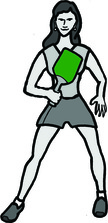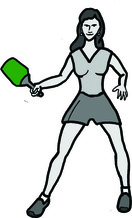You tell yourself to calm down, but the next shot comes. You call out, "I've got it," only the ball bounces lower than you thought it would, and your return doesn't clear the net.
You take a deep breath. "Starting over now," you say. "That shot is history. The slate is clean." Then your opponent calls the score. "Four, one, one." How did they get four already?
It's easy to spiral down during a game and much harder to get back up again. But that's exactly what you have to do, or your play will continue to disintegrate as you turn the game into a mental comedy of errors by thinking too much. It also doesn't help when your partner says, "Oh, darn," after every poor shot you make.
I've seen two recent games plummet into oblivion this way, What should you do when everything goes wrong?
First, everything probably isn't going that badly. We tend to focus on the "bad stuff" and forget our other shots that cleared the net, didn't go out of bounds, and were occasionally awe-inspiring. But you shouldn't even focus on those. Instead, concentrate on the ball and the player hitting it.
Don't say anything when your shot goes into the net. Be quiet when it goes out of bounds. Don't tell your partner you're sorry, and don't curse—not even "Oh, darn." Instead, let those thoughts wash over and away from you. The last shot is in the past, and you should be getting ready for a new one. Save your voice for telling your partner, "I've got it," or "yours," and "that was a great shot" when she puts it away.
When everything goes wrong, stop play for a few moments. Put your paddle down and walk away from it. Take a water break. Shake off negative thoughts. Come back to the court refreshed and ready to start again. I've seen many a game turn around when someone does this—including my own recently.



 RSS Feed
RSS Feed